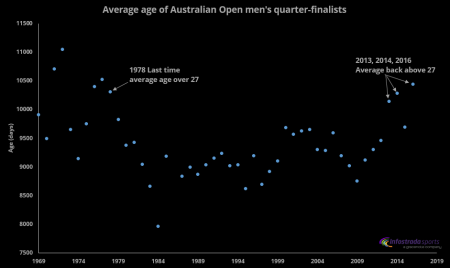TENNIS – Six of this year’s quarter-finalists in the Australian Open men’s singles are over 28-years-old for the first time in the competition’s history. The average age of the eight quarter-finalists is the oldest since 43-year-old Ken Rosewall reached this stage in 1977.
At the beginning of the open era, players well over the age of 30 were reaching the last eight of the Australian Open so, for example, Ken Rosewall (37), Mal Anderson (36) and Barry Phillips-Moore (34) all played in the quarter-finals of the 1972 tournament. Rosewall even went on to win the tournament and the Australian is still the oldest Grand Slam men’s singles winner. Players aged 33 or over have rarely been successful since then though with, prior to this year, only Andre Agassi (2005) and Fabrice Santoro (2006) reaching the last eight of the tournament since the 1970s.
Roger Federer and David Ferrer’s presence in this year’s last eight make the 2016 Australian Open the first since the 1978 tournament in which two players aged at least 33 have made it to this stage. In that tournament it was Arthur Ashe and Tony Roche. Ashe went onto the semi-finals that year aged 35, something no one of his age has achieved since.

A year after Ashe’s semi-final appearance, the average age of the eight players to reach the Australian Open’s last eight fell below 27 and didn’t rise back above that level until three years ago. This year is now the third time in the last four Australian Opens in which the quarter-finalists have averaged above 27 years old, something which hasn’t been seen since the late-1970s.
At the other end of the age scale, Milos Raonic is the only player in this year’s men’s singles quarter-finals aged under 26. Compare that to the 2009 Australian Open when Roger Federer and Andy Roddick were the only players above that age to reach this stage.
The world of tennis appears to have changed with this generation of players remaining at the top for longer, making it harder for the younger players to break through. Canadian Raonic was the only player born in the 1990s to be seeded in the top-15 at this year’s Australian Open and a player born in that decade is yet to win a Grand Slam. If the first Grand Slam winner born in the 1990s had followed the pattern of players born in previous decades, we would have had a 1990s-born Grand Slam winner by 2014 and as early as 2009 as the table below illustrates.

No player born in the nineties has reached a Grand Slam final yet either with the best performances being the semi-final appearances by Jerzy Janowicz (Wimbledon 2013), Milos Raonic (Wimbledon 2014) and Grigor Dimitrov (Wimbledon 2014). Last year Raonic’s Australian open quarter-final appearance was the best by a player born in the 1990s, along with Vasek Popsipil’s quarter-final at Wimbledon.
Time will tell whether this trend sustains itself because of better fitness training and the advancements in sports science or whether it is due to an exceptional generation who have been around at exactly the moment that these advancements led to career prolongation for the first time. There is little doubt that the likes of Roger Federer and Novak Djokovic belong amongst the greatest players of all-time but perhaps Murray, Berdych and Ferrer would also have won more Grand Slams had they not had the misfortune to be active during the Federer-Nadal-Djokovic era. Therefore the young players of today may be dealing with many more players of exceptional talent than previous generations and, once the golden generation finally retire, the youth may rise again.